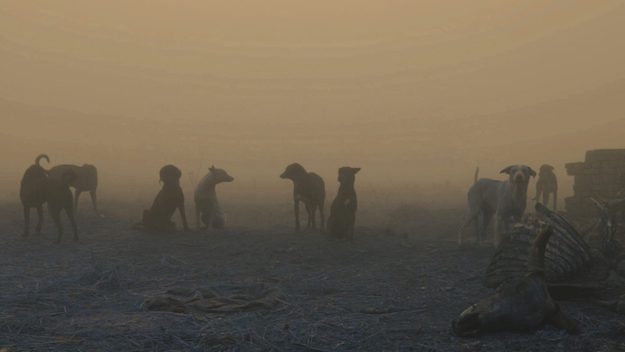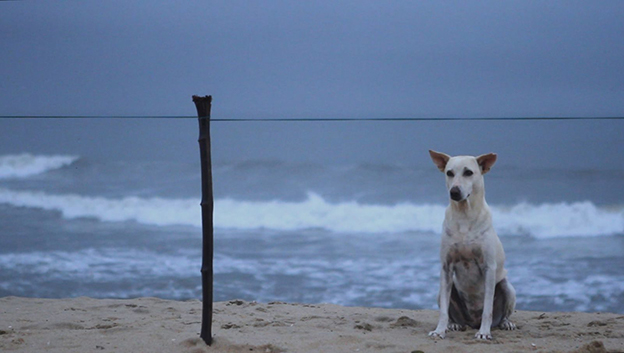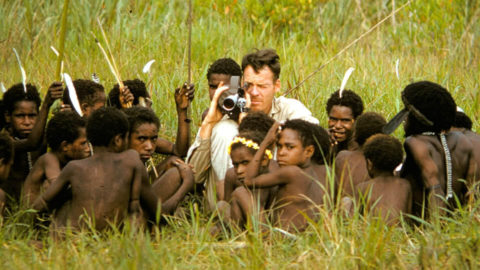Interview: Ekta Mittal
Absence screens Sunday, February 10 at the Film Society of Lincoln Center as part of Film Comment Selects.
Poised in an otherworldly space encompassing rural villages, forests, and urban labor communities across India, Ekta Mittal’s Absence (Birha, in its original title) observes the lives of those affected by the country’s waves of migration. Through perspectives drawn from the workers who have disappeared into the cities, as well as from the women who have been left behind, the film serves as an intimate meditation on the complexities and nuances of separation, loss, and desire. Although Mittal’s subjects remain unidentified throughout, certain characters emerge as anchors within the film; an elderly woman ritually kneading dough; a young woman preparing herself with jewellery and sindoor; and a disappeared laborer whose voice-over and fantasies invoke both the hardship and enticement of migrancy.
Absence, Mittal’s first feature documentary, grew out of the relationships she formed with migrant workers on an earlier project Behind the Tin Sheets, a series of short films observing the lives of migrant laborers building the metro in Bangalore. As Mittal documents the daily rituals of her anonymous subjects (without identifying locations), Absence becomes a dreamlike blend of visual and sonic impulses, with the work of the Punjabi-Sufi poet Shiv Kumar Batalvi as a central influence.
Alluring and ghostly in equal measure, Absence receives its U.S premiere on February 10 as part of Film Comment Selects at the Film Society of Lincoln Center. Prior to the screening, I spoke with Mittal about the film’s history and influences, its bracing sound design and landscapes, and the arresting characters we encounter throughout.

To begin, could you explain the meaning of the word birha?
I resisted translating birha into English because it’s not really absence—it’s the lamentation, the pain, and the grief that is caused by separation. In India it’s been used in various different languages and in some ways it comes close to the meaning of separation. In this film context it’s also derived from the Punjabi-Sufi poetry where birha is a very important kind of feeling that everyone must go through. The whole point is that you can only move ahead once you sense this pain of separation. When I say move ahead, I mean for people to go further in their own quest for the meaning of themselves, or in the quest of the divine.
The poet Shiv Kumar Batalvi is a birha poet. I was inspired to find his poems because they spoke to some of the themes that I was exploring in the context of understanding the word separation, considering that I was in locations where I was looking for families of workers who I had met in Bangalore. In one of his poems he says that you are as good as a corpse if you cannot really experience birha. It’s a crucial emotion for a mortal being to experience. In many ways I think it is true that separation is inevitable and one must find ways to free oneself of these attachments that we are clinging onto. And it is through enduring that pain that you can understand various things, whether it is love or longing or detachment or alienation.
When you began to make this film, had you already researched Batalvi’s poetry or did you come to it in the filmmaking process?
I came to it in the process of making the film because this is part of a longer project called Behind the Tin Sheets, which I started with my friend in Bangalore when the metro rail was being constructed. So while we were at protests fighting this monstrosity that was cutting through the city, we found that the battle was much larger than us. The city had already started becoming alienating for us and we felt perhaps we could speak to visitors to the city, who are the migrant workers building the metro, and see if there was a meeting point between how we were feeling. A lot of things had started to disappear, to vanish and be demolished, and in this process to talk to someone who had no idea what the past was might be an interesting conversation to explore. So we made three films that stemmed out of the conversations that we had with migrant workers. We chose to look at him as a poet or thinker, a philosopher or lover, a human being who misses home, who has sexual fantasies, so it works with various themes and thematics.
Some of the relationships I made with the workers were very strong, and it felt like I had barely scratched the surface. I felt like I needed to understand where this was all really coming from. What are the roots of his journey? I went back to five or six very close friends’ homes and lived with their families and absorbed what everyday life was. There was one worker who I was looking for, so I used to go and travel and come back, and I just wanted a hook. I was looking for poetry because I feel when I have so many experiences inside of me poetry really rescues me. It holds everything together. I was looking for poems that would help me to go deeper into this idea of what it would mean for someone who’s disappeared and who’s not coming back home again. I stumbled upon Shiv Kumar Batalvi because he’s written a lot around separation as well. Maybe two and a half years after I started working on the film I found his poems. Most are visual metaphors that in my view can be made into really beautifully shot films.
One of the most striking aspects of the film is this sense of placelessness. As a viewer you feel that you are intimately in people’s homes and communities but the actual settings, both rural and urban, are very unplaceable. How did you choose where to shoot in the rural settings?
I left Bangalore to try to meet people in villages I was going to for the first time in my life. For me the placelessness of it is very crucial because, especially in India, I wanted to move away from saying this is Chhattisgarh, this is Bihar, this is Punjab. I wanted the viewer to stay with the mood and emotion and to traverse through the feeling of this fictional village, kind of another space, another universe, where all these people are residing and they have a connectedness, but their ways of experiencing separation are quite different. So in a way I was also subconsciously trying to get these characters to meet in my own kind of dream space, because I was the only point of contact with all of them. For me a place becomes a character in itself, or the state of mind of birha is a place in itself. So it allows me to not worry if I’m moving from the forest to the mist. Those kind of barriers didn’t exist when we were editing the film because I was very clear that we had to stay with a state of mind, the journey of birha in that sense.
When you have that distance from the notion of space and place and time, I think different kinds of connections start to happen. When we were shooting in the mist, one of the ideas in my head was that, if the missing people aren’t dead or alive, then where are they going? Is it a place we cannot see? Are they watching us and we can’t see them? So the mist really opened up this conversation about the infinite landscape. I particularly chose to shoot the film in winters and monsoons, so that also has a mood that allows you to reflect and think. We didn’t take the camera with us to many of the places we went to and we used to just spend time walking and absorbing the environment.
The atmosphere is incredibly tangible, particularly as a result of the soundscape. How did you go about recording for the sound design?
The sound design is many layers. I was quite sure that if I was not going to have the idea of time and place, and not going to name the people in the film, then there had to be something that connects it all. And the only answer I came to was that sound has to do that job. There was a very disciplined schedule of field recordings that happened in all the locations. It actually didn’t work because Punjab is extremely noisy. Sometimes even getting the interviews would be very difficult. I had to wait until everyone was asleep at like 10 p.m. and then have an interview. So then I realized it had to be disembodied and I had to work with non-diegetic sounds. I knew that the sound of the forest was a way for us to stay with the mystery and ambiguity, but also draw someone’s attention in. You hear a swarm of cicadas in a forest and it invites you to keep going further. Wherever I was, I was trying to be especially attentive to the sound of insects and I realized they have an immense quality, especially if they are in large numbers. That got me to listen to a lot of field recordings done in different parts of the world and I found a really fantastic set of recordings which shocked me because some insect sounds, when you listen to them after a while, start sounding musical. Most of the sounds in the film are actually cicadas.
With the music I was again looking at the mood of the film. I wanted a thread of music that could faintly appear and disappear and hold the viewer. Whenever you see the woman dressing up with the moon behind her, you hear this chamber choir of women singing. On the one hand I wanted to invite people into the space but I also wanted to have this moment when one could feel very alienated. What you’re seeing and what you’re hearing are totally contradictory and alienation is also something that one has to experience. Even though we have all these elements, we wanted the film to have a quiet tone, to find this quiet space inside people. It’s extremely violent right now in India, and if you look around at the struggles that the people in this film are facing, it’s a really violent experience in life, it’s difficult and disturbing. So my quest was to find that small passage where maybe there is a quiet inside everyone. There has to be something beyond what one sees. And I feel sound plays that role.

You mention the scenes of the woman with the moon behind her, in which she’s dressing herself with jewellery. The burden of birha seems to be borne specifically by women, or rather it is borne in a specific way by women. And the way that this woman is performing for the camera, the way she is dressing up, it almost seems like a performance of waiting.
I think the act of performing within a marriage, sometimes within a relationship, is there for both men and women. This character to me symbolizes a kind of audacious courage. Actually you cannot penetrate this woman. OK, you are watching her, but she doesn’t say anything, she’s just dressing up. I don’t necessarily think I need to feel sad for her. Toward the end when she’s taking off her bindi and her sindoor and her bangles, she’s at a point where she’s like, “I’m not telling you where I’m going after this.” We don’t know what her quest is. And I don’t want to lock her up with this idea of someone dressing up and waiting for a man who doesn’t show up. Because I wanted to treat her with a kind of…
With her own agency.
The classical idea is not what I wanted to represent—the idea that, without my husband, who am I? I think women have always explored and are very imaginative, and have discovered love in many beautiful ways. It just so happens that society and morality do not want women to, but that doesn’t mean it does not exist. Women have explored their sexualities in extremely beautiful ways in India and this has nothing to do with being educated or coming from a particular socio-economic class.
The moon is also a very important metaphor, because it’s a witness to this. There’s a beautiful poem called “Sheesho,” written by Batalvi, and in that he talks about the cycles of the moon. It always watches absurd forms of violence, it’s always watching from a distance. In Sheesho, the moon actually takes on a very masculine position and falls down because it is ashamed that it cannot do anything. It can come into very intimate spaces, moonlight. It may enter into spaces where it shouldn’t have seen something. It eventually realizes that what it saw is so terrible that it needs to vanish, to fall off, to be ashamed. It is an interplay, then, between the witness, which could also be a metaphor for us. We know that these things happen but we choose not to say or do anything about it. So the woman is also just there, she’s not going to show you everything. The moon already knows, it has already seen. These are mundane things. It happens every day and there is nothing unusual or extraordinary about this. In my view it’s a universal thing, in the context of relationships. It just takes this form here because of certain cultural and traditional values, but it’s more or less philosophically the same.
There’s a particular moment that really stands out to me. It’s toward the beginning of the film, after we go to the city and hear one of the workers speaking. It cuts to a woman dancing and she’s bathed in a bright red light. It’s such a contrast to the rest of the film. How did that scene come about?
Pervez is a very close friend of mine. He hasn’t gone back home in 15 or 17 years. He doesn’t desire to and it’s pretty obvious in his narration. He talks about how he’s afraid of being at home because of all the fights. He’s one of those people who would be a missing person back home, because he hasn’t returned. So I am meeting the missing person in that sense. He’s Muslim and he’s discriminated against. He doesn’t like to take shit from anyone. He’s quite a charged guy, he has a short temper, and his way is to usually be by himself. When I asked him about things like love, it is a very tricky situation because he knows that on the one hand it is there, but on the other it cannot be complete. There have been a lot of sexual fantasies that he has shared with me at points. In the film I’m trying to show that there is also a fatigue to the sexual fantasy. So when this girl is dancing or performing, it’s because he cannot sleep and he has these dreams, but they are also interruptions. There’s a constant tussle with the woman that he desires because she can never be his, because he doesn’t know where he is going to be, because he might disappear. The woman is dancing but she gets tired. Imagine that the person in your dream is also tired. But does he want this woman for real? Or does he just want to leave? There’s an assumption that the man is always out to oppress the woman, or to be with the woman, but it’s probably not true. There are other ways of understanding masculinity. The intercutting is there because there is always a woman on his mind. He doesn’t want to be there and that’s why he disappears by the end of the film. He’s also another film in itself.

Each of them is a story within a story within a story. Are you currently working on projects related to this film?
Yes, I think I’m going to do this until the end of my life. I’m pushing myself in the context of taking risks, challenging my own mobility as a woman, thinking about conversations with men, what kind of conversations you can have. So my next film will be connected, hopefully. I’ve just started working on it and it will take me a long time. The film has to go back to the road I think and to the various encounters that happen on the road, whether it’s with prostitutes, other truck drivers, night creatures. What is life on the road? It’s hopefully going to be a crazy experience. I mean even the guy I was looking for in the film, the character I’m looking for with the photograph, it’s bizarre, I just found him four days ago. It’s insane. I went back, because I said it’s my last straw and I need to do this. I’m trying to also tie up things in my own head. He was more shocked than me.
How long had you been searching for him?
Ever since I had started making the film. I had five people who I had chosen to go back to, Pervez and Pooja, who are there in the film, and Surender. Because I had their addresses the intention was to go meet them and say I’ve made these three films [Behind the Tin Sheets], what do you think? I never found Surender. So then the act of searching itself became an aspect of the film. In Punjab I met the very old woman. For me her character is really strong. Her silence is impenetrable. The repetitive act of her making chapatis. It’s in the mundane that you move beyond the action and it’s able to take you somewhere else. Her son has gone missing but it is not important for me to bring that out. Sometimes I do question the documentary form and wonder how it is possible for people to just talk about their experiences—why should this access be so easy? What if I showed you something else about her life and for us to engage with that? So the film is also a challenge to the documentary way of looking at people’s lives and experiences.
The imagery in the film says so much more than what can be articulated in words. It’s not about the specific details of things, but the feelings.
The idea was not to be descriptive, but to leave people to speculate, whether it’s about the person or about themselves. I think it’s really important to speculate, not to get into the details of where the person is coming from, how many children they have. How many more documentaries from India do you want to see where people are constantly in these awful situations? Yes, things are bad, but we figure things out.
Naomi Keenan O’Shea is a freelance film critic. She grew up in Dublin, where she received her B.A in Film Studies and English Literature from Trinity College.





